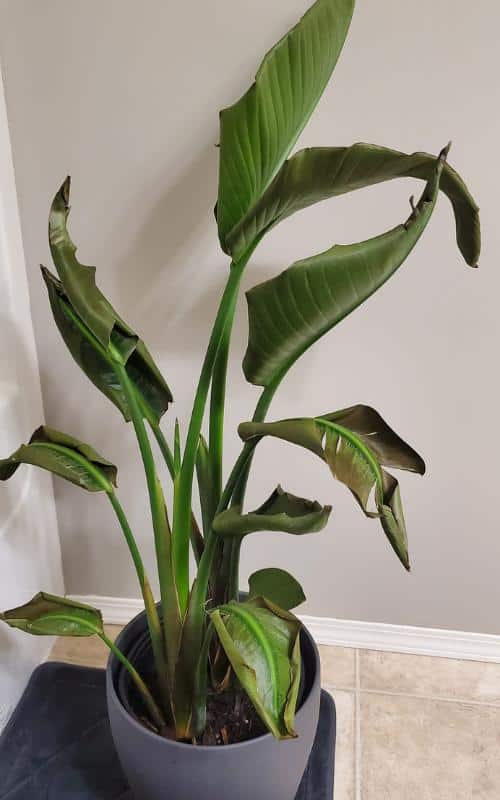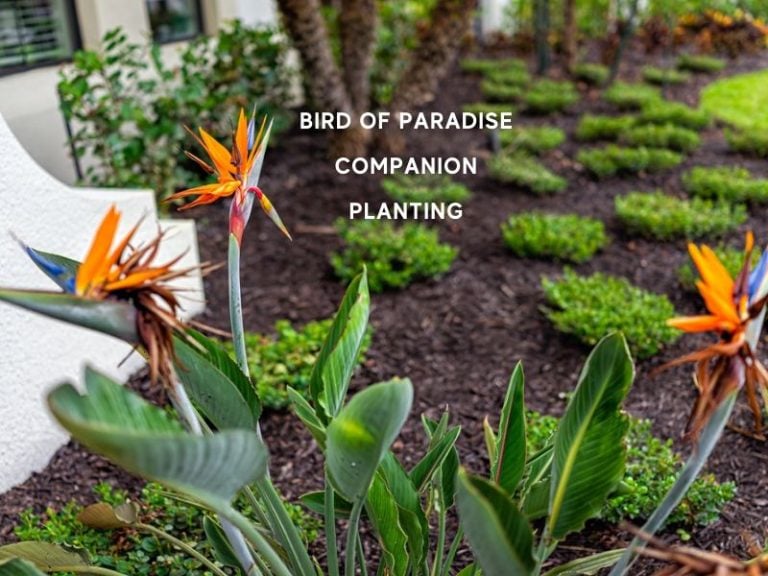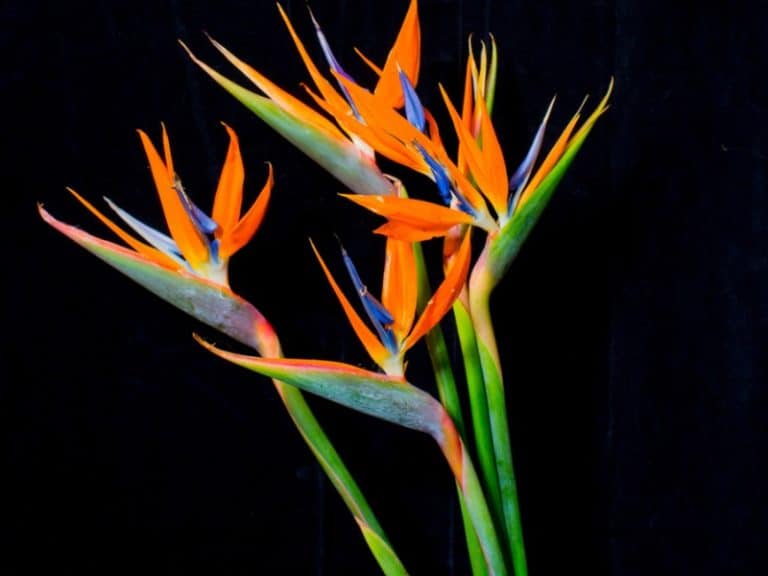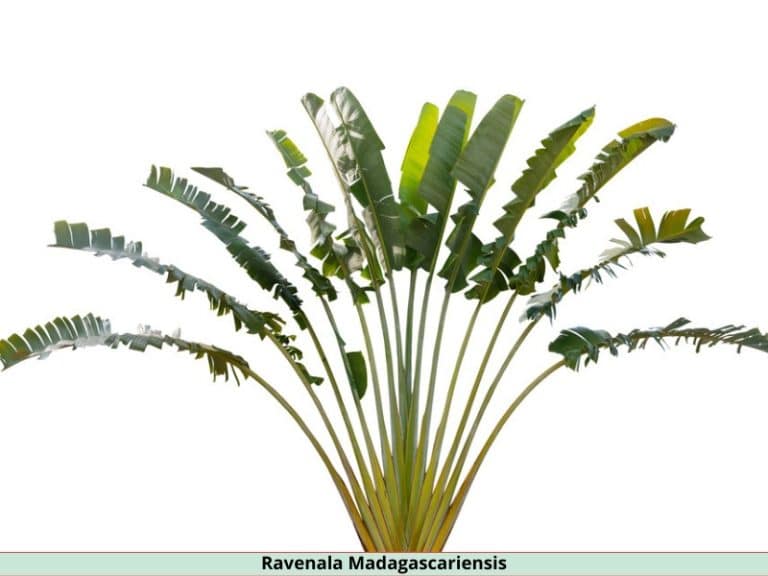Bird of Paradise Care – Watering, Pruning, Light & More
| Names | Bird of Paradise, Strelitzia plant, crane flower |
| Sunlight | Full sun; tolerates partial shade |
| Water | Once every 1-2 weeks |
| Temperature | 55°F to 75°F |
| Humidity | 60-70 percent |
| Soil pH | 5.5-7.5 |
| Growing zones | 9b, 10, 11, 12 |
| Size | 4-6 feet tall, 3-4 feet wide |
Caring for the bird of paradise is pretty easy. The most basic care requirements are growing the plant in a suitable medium, positioning its pot in indirect sunlight, and watering it once every 1-2 weeks.
The bird of paradise plant can be established from seeds or by propagation. Seeds are sowed directly on the soil, while propagation involves growing subdivisions from the parent plant in newer media. Once established, the plant matures and starts blooming.
Care requirements for the bird of paradise plants

Various factors successfully grow the bird of paradise plant outdoors and indoors. Temperature, water, sunlight intensity, and humidity are the most vital elements for growing the bird of paradise plant. Providing these essential growth elements produces a healthy plant with large, beautiful leaves and colorful flowers that accentuates their location.
Here’s an ultimate guide to grooming your strelitzia plant correctly.
Sunlight
The bird of paradise is a tropical plant and thus prefers full sun to thrive when grown outdoors. Indoor plants require bright, indirect light to keep their leaves green and healthy. Place them near eastern and western windows for about 4-6 hours daily. South-facing windows may not make the best spots for indoor strelitzia plants. Relatively dark rooms may need a grow light lamp to provide the plant’s light.
Water
Strelitzia plants need watering more often when actively growing in spring and summer to help speed their growth rate. During this period, hydrate the plant once every one or two weeks. The soil should be moist and not overly wet or soggy.
Overly wet soils can cause root rot disease. The soil should not be arid, as it makes the leaves curl and turn yellow and brown at the tips and edges.
Water the plant when the topsoil is dry and the soil underneath is moist. Dip your finger in the top 2-3 inches of soil to check dryness for the next watering.
You may want to water less often in autumn and winter since the plant is less active and doesn’t need much water.
Filtered tap water is suitable to avoid supplying excess salts to the soil.
Rinse the soil until excess water seeps through the drainage holes under the pot and into the saucer. Dispose of the collected water to keep the saucer dry.
Humidity
The strelitzia plant prefers warmer locations with 60-70 percent humidity. However, growing it indoors may need adjustments. Place your strelitzia plant away from air conditioners and heating vents as they dry moisture and reduce humidity.
Mist the plant daily to keep the air moist. Rub the leaves gently with a soft cloth while misting to remove any dust on their surfaces for efficient photosynthesis.
Install a humidifier around the plants to maintain high humidity. Alternatively, place the pots under a pebble tray.
Soil pH
The strelitzia plant can successfully grow in soils with a pH ranging 5.5 to 7.5. You may want to check the soil pH before planting.
Take a soil sample to a nearby local university extension for testing.
Soil type
The bird of paradise plant thrives in various soils provided it’s well-drained and nutrient-rich. Adding some compost to the mix during potting enriches it with nutrients.
The pot should have enough drainage holes to allow excess water flow during irrigation.
Growing zones
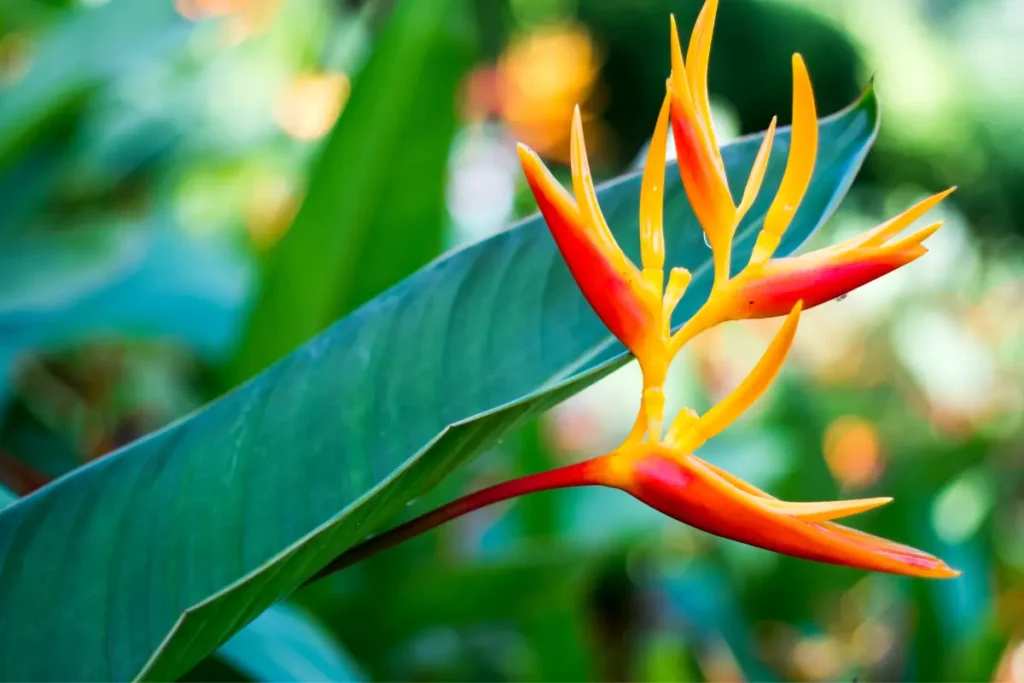
Since temperature dramatically affects the survival of the bird of paradise plant, choosing locations with favorable minimum winter temperatures is vital.
Otherwise, cooler winter temperatures would freeze the plant, damage its parts and kill it.
The bird of paradise plant is hardy in USDA zones 9b-12. USDA zone 9b has the lowest temperatures between 25oF and 30oF, and the crane flower can survive if taken indoors during winter.
Meanwhile, USDA 10 is the most favorable zone for most strelitzia plant varieties since it has a low-temperature range of 30oF-40oF. These slightly higher winter temperatures wouldn’t freeze the plant and kill it.
Strelitzia plants can grow outdoors throughout the year in warmer zones 10-12 climates.
The table below summarizes the zones, states, and cities where the bird of paradise plant can survive:
| Zone | State | Cities |
| 9b | Louisiana | New Orleans |
| Florida | Orlando, Tampa | |
| Arizona | Tusco, Phoenix | |
| 10 | California | San Jose, San Gabriel, San Francisco, Loslos Angeles |
| 11 | California | San Diego |
| Florida | Miami | |
| 12 | Hawaii | Honolulu |
| Puerto Rico | San Juan |
Temperature
The indoor bird of paradise thrives in temperatures between 55oF and 75oF. A daytime temperature of 65oF to above 70oF is favorable, while 55oF and 65oF at night is good. Lower temperatures of 24oF can significantly damage the foliage and flowers, beyond which the plant dies.
While strelitzia plants actively grow in summer, the foliage can get damaged from the high midday heat.
Remove your plant near south-facing windows to protect them from the direct summer heat. Bring your outdoor potted strelitzia plant inside to protect it when prolonged winter cold is approaching.
The table below summarizes the most basic care requirements for the strelitzia plant:
Mature size
Strelitzia plants take 3-5 years to mature and bloom. A mature plant is 4-6 feet tall and 3-4 feet wide.
Indoor birds of paradise grow slowly in the first two years, then rapidly increase their size over the following years. They double their size in the first two years, adding about one foot yearly but barely reaching 6 feet tall.
Meanwhile, outdoor bird of paradise plants grow faster due to exposure to direct sunlight. A small outdoor plant takes two years to establish and about three years to mature and bloom.
The plant produces several stems, usually cut into minor divisions to start other plants. However, the parent plant will take up to three years to recover before flowering again. An outdoor strelitzia plant can grow up to 6 feet tall.
Potting and repotting
Potting young plants or divisions is the best way to propagate the strelitzia plant. Although you can sow seeds in pots, they take longer to establish, usually 3-5 years.
Potting is also necessary for growers in zone 9b to quickly move the plant indoors when a colder winter is approaching.
Potting requires a nutrient-rich, well-draining potting mix and a container with at least three drainage holes.
Young plants require smaller containers with room to allow for the spreading of the robust root system. After potting, put the plant in a room with indirect sunlight. Water it regularly to promote faster growth.
Strelitzia plants need repotting to encourage them to flower and their foliage to be more significant to unleash their beauty.
Repotting should be done every two to three years in spring or summer when the plant is actively growing. Don’t report dormant plants during fall and winter since the roots won’t recover quickly from the repotting shock.
Young plants may need repotting yearly to grow robust roots for more firmness when developing foliage and flowers after maturity.
Repotting is also necessary for plants with little foliage less than 3 feet tall to promote firmness and faster leaf growth.
You need a new container with fresh, well-draining, nutrient-rich potting mix to repot. Follow the steps below to repot your bird of paradise plant:
1. Rehydrate the soil in the old pot
Water the potting mix before removing the plant to make the plant come out quickly without damaging its roots. This will also help to protect the roots from intense shock after being repotted.
You can check the wetness of the soil by dipping your finger and dry water soils.
2. Select a wider container for repotting
Repotting a plant requires a wider container than the previous one to create room for the rapidly spreading roots. The pot should be two inches wider and have enough drainage holes. Bring along a new, well-draining, and nourished potting mix.
3. Spread the potting mix in the new container
Add the fresh soil or mix to the pot.
4. Transfer the plant from the old pot to the new pot
- Hold the bird of paradise plant with its stem and gently pull it from the pot. Be careful not to damage the roots because they would be adversely shocked and take longer to recover.
- Rinse the roots with a hose to remove the old potting mix before transferring them to the new pot.
- Place the plant into the new pot and fill any gaps around the roots with the mix to make it firmer and upright.
5. Water the plant
Hydrate the bird of paradise plant with a lot of water to help the roots recover. Water until the excess water flows through the drainage holes below the pot.
Let the top 2-3 inches of soil dry out first, but not entirely, before the next watering. Depending on weather conditions, the next ideal time to rewater is after 1-2 weeks from repotting day. Don’t water the plant when the soil is damp to avoid promoting fungal and bacterial infections.
A mature bird of paradise plant’s root would take approximately two weeks to recover from the repotting shock if they were not damaged.
Feed the repotted plant once every two weeks with a balanced liquid fertilizer to promote faster growth and blooming.
When to prune strelitzia
The bird of paradise plant doesn’t need pruning often to keep it healthy. However, pruning is necessary for overly faded and damaged flowers and leaves. Use a sharp pair of shears to remove damaged plant parts.
Wipe the cutting object with a soft cloth dipped in rubbing alcohol to sterilize it after a few cuts when pruning sickly plant parts.
Pruning is also suitable for overly grown foliage to reduce their size. Cut them to the desired size when the plant actively grows in spring.
Toxicity to humans, cats, and dogs
The strelitzia plant is moderately toxic to pets and humans when they ingest its leaves or seeds. The foliage has hydrocyanic acid, while the seeds’ pods contain tannins, which are toxic components meant to protect the plant from harmful predators. Indoor strelitzia plants may not have seeds, but their leaves will still be harmful.
Ingesting the toxic parts causes gestational problems, which cause vomiting, diarrhea, and nausea. Keep small kids and pets away from your strelitzia plant to avoid poisoning.
Common diseases
Only a few diseases affect the strelitzia plant. Root rot is the most common disease that might be problematic when growing this plant, but watering with enough water when the topsoil is dry is enough to control this disease.
Many fungi can also invade your strelitzia plant, leading to fungal infections. Treating fungal infections can be achieved by using systemic herbicides labeled for houseplants.
Otherwise, keeping your soil moist and growing the plant indoors can easily keep these diseases at bay.
Common pests
Mealybugs, spider mites, aphids, and scale are the most common pest you will deal with when growing a strelitzia plant.
An indoor bird of paradise plant is mostly pest-free, but pests can easily invade it when you take it outside during summer for direct sunlight. Pests from other plants can migrate and quickly attack a strelitzia plant grown outdoors.
Mealybugs and aphids suck saps from the bird of paradise plant and deprive it of moisture. Pest adversely affects your strelitzia plant resulting in stunted growth, curled leaves, wilting, and drooping, and the plant might die if not treated.
You can treat pest infestation by rubbing the foliage and stems with a soft cloth dipped in water to remove them. Hosing the pests also removes them.
For heavy infestation, spray neem oil on the pests to kill them. The neem oil will also repel the pests to prevent re-infestation. Systemic insecticides work perfectly in controlling the pests chemically.


